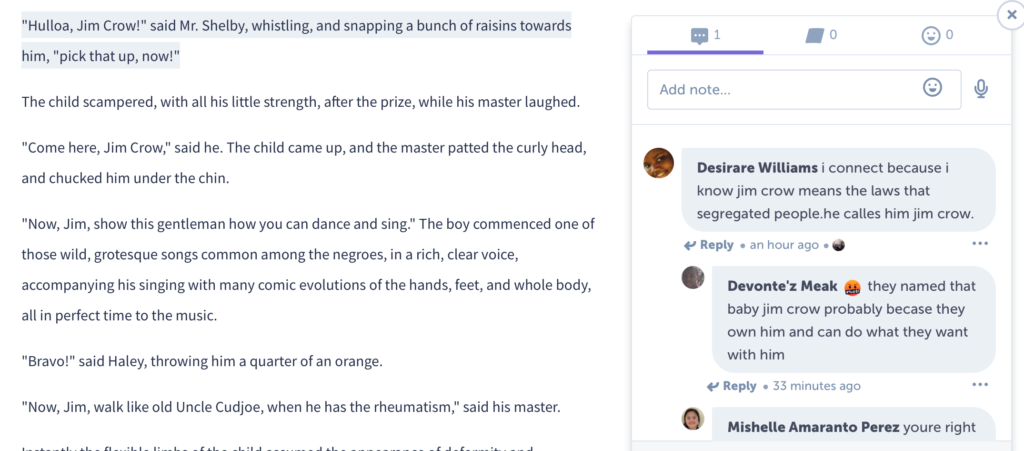Embedded Writing Prompts Deepen Reading Comprehension
Christophe Spy/ August 22, 2020/ Classroom Tips, eBooks, ELA, Teacher Tips/ 0 comments
Without fail, my middle school students will ask me why they need to be writing when I was, in fact, teaching them reading. And without fail, I would tell my middle schoolers, “you will be able to write well the more you read, and you will read well the more you write.” While this may have sounded like typical teacher-speak to them, to me this answer underscored a fundamental truth of literacy in middle and high school – writing is essential to teaching reading. And for me, writing prompts are an essential tool to make writing happen.
Researchers Steve Graham and Michael Herbert explain the relationship between reading and writing further in their study “Writing to Read: Evidence for How Writing Can Improve Reading”. They found that “having students write about the material they read does enhance their reading abilities. In fact, fifty-seven out of sixty-one outcomes (93 %) were positive, indicating a consistent and positive effect for writing about what is read,” (Graham & Herbert 2010). With data like that to back up the reading/writing relationship, teachers can be assured that being intentional with embedding time for students to write about what they are reading will lead to increased engagement and comprehension for their students.
When students are reading, they use both metacognitive and cognitive reading strategies to help them comprehend the text. A 2013 study, “The Importance of Metacognitive Reading Strategy Awareness in Reading Comprehension”, helps to define these terms with metacognitive reading strategy awareness being “strategies that help students to regulate or monitor cognitive strategies,” and cognitive strategies are “direct interaction with the task that help to facilitate comprehension, act directly on incoming information, manipulating it in ways that improve learning.” (Ahmadi, Ismail, & Abdullah 2013). The team explored the impact of using reading strategies on reader outcomes and found that students who are more metacognitively aware of how to use reading strategies have higher levels of understanding than those that do not.
In my classrooms, writing prompts to help students shift out of the role of passive reading and into becoming active participants with their texts. I’ve found that students who are given opportunities to write about their texts as they are reading have deeper comprehension, especially students that struggle with grade-level texts or are learning the English language.
This means that by purposefully teaching students to write about what they read while reading allows them to dive deeper into and work through the nuanced and complex sections of the text. When I use writing prompts with my students, I use four strategies to grow their level of interactions with the text.
Strategy 1: Use Prompts as Checks For Understanding
Provide your students with writing questions that will assess basic understanding of the text. When students are aware of the questions beforehand, you target their purpose for reading. Choosing to use writing prompts as checks for understanding (CFU) is time efficient, shows student thinking and possible misconceptions, allows the chance for differentiated intervention before students get too deep into the text, and builds relationships with students by providing ongoing feedback. You will want to use writing prompts that have longer answers, require understanding of the text, and have multiple possible entry points (no one absolute specific answer). Below are a few prompts that solicit students to share their thinking about the pivotal parts of the text and still provide insight for teacher support:
- “Why did the character react the way that he/she did?”
- “What can you infer about ___?”
- “How did the character accomplish ___?”
Try asking these questions on your Glose classroom feed by writing out the page number students must read to before they can respond. Then, solicit student responses to these CFU prompts by having them upload their written answers into your connected Learning Management System. For the CFU prompts, it is important for students to individually reply privately so that you can assess who truly comprehends the text and who needs your extra help. Here’s an example below:

Strategy 2: Justify Reasoning by Citing Evidence
As students are working through the CFU prompts, teachers can push reading strategies further by asking students to include evidence from the text within their responses. These will be longer answers and take more time than the quick CFU questions, but will provide teachers with valuable data on student thinking. Students will stretch their grasp of the text by having to find portions that back up their inferences, and prepare them for higher learning institutions. Here are a few prompts that encourage readers to find evidence that support their thinking:
- What are three quotes from the text that support the idea that ________?
- How do you know that _______? Cite three sentences from the text that support your thinking.
- What are two things that led up to ______? Cite your evidence directly from the novel.
In your Glose feed, add these prompts and have students reply with supporting evidence. Since everyone will be able to see their evidence examples, have students reply to each other’s highlights by adding notes into the margins of the text that explain how and why they chose those specific selections, and whether they agree with the original poster or disagree. The teacher will be able to see individual student responses with evidence and students will grow by collaborating with their peers by building off of their responses. Struggling students will be supported by having examples that will help them in their own responses. Here’s how I incorporated this:

Strategy 3: Make and Respond to Connections
Another strategy we want students to metacognitively use when reading is making connections to other texts, to themselves, and to the world around them. When students make connections, the reading becomes real and they are more likely to solidify their understanding. Here are a few examples that encourage students to make connections:
- How does ______ remind you of our last novel?
- When have you encountered ______ in your life?
- How does this theme relate to social justice work in our city?
In your classroom feed, have students react using the emoji icons to these pivotal portions of the text. Students then comment on what connections they have made and why the connection is important. Students will benefit from connecting their reading to something they already know about, reading peer connections and commenting on them, and be excited to share their learning with others. Look at the deep thinking my students collaborated on to make connections:

Strategy 4: Reevaluate and Assess Thinking
To push students in making deeper meaning, teachers need to teach them reading strategies on how to reevaluate and assess their own prior inferences and thinking based on new parts of the text. As students are reading more of the text, prompt students to go back to a previous inference and now revise their inferences as they’ve learned more:
- How has your initial inference from chapter 1 changed now that ________?
- How did the author’s way of using dialogue in chapter 5 change what you thought about _____?
- Do you still think the same way about _____ now that you’ve read this section? Why or why not?
On your feed, ask students to go back to one of their first inference prompts they have responded to. Have students comment right into their old post to provide an update to what they now are thinking. Push further and have students cite evidence from the later section of the text that they are using to reassess their previous thinking. Teachers will be able to see if students are using later evidence and if they are updated their thinking as needed in regards to the new events that have happened in the text. Here is an example of a student going back to revise a first opinion:

It is important to have students answer writing prompts as they are reading so they can read for purpose, which allows them to unlock meaning. By having writing prompts a regular part of your classroom reading work, you are providing students plenty of ‘at bat’ practice opportunities and students learn that this strategy works, which will then become part of their metacognitive reading awareness skill set that they can use whenever they are grappling with complex texts. When students respond to their reading through writing, they grow as readers, which is always our ultimate goal as an ELA teacher.

About the Author
Samantha Reichard serves as Lead Real Time Teacher Coach for Center City 1 Learning Community in Charlotte, NC, serving as a mission-critical resource for 29 inner-city and Title I schools in the Charlotte Mecklenburg School District. After graduating from the State University of New York at Fredonia, Samantha began her teaching career at East Union Middle School in Union County, NC as an eighth-grade English language arts teacher. After two years, she moved to Charlotte, NC and served as a sixth- and seventh-grade language arts teacher for five years before becoming a multi-classroom leader and real-time teacher coach. Following that, she worked on expanding the model of Multi-Classroom Leader and Real-Time Teacher Coaching (RTTC) for four years at Ranson IB Middle School.
